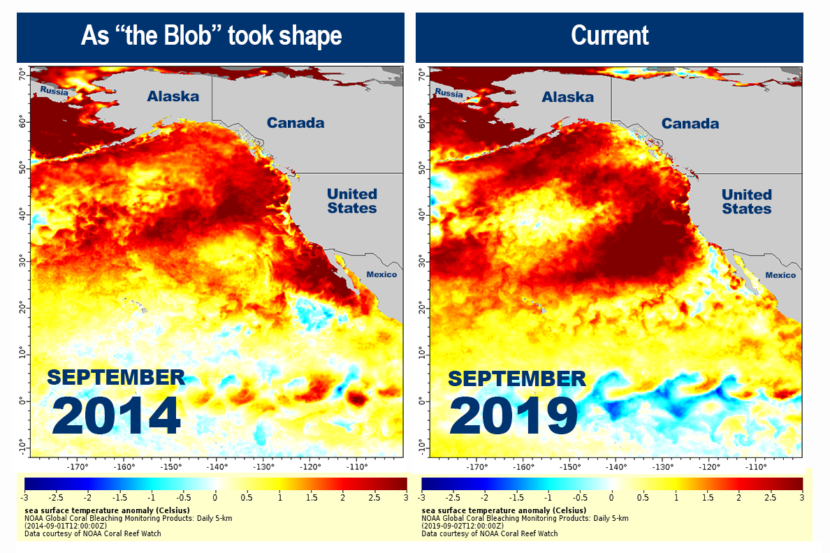
Scientists from the National Oceanic and Atmospheric Administration announced on Thursday that millions of square miles of water in the Pacific Ocean are heating up. They’re calling it a marine heatwave, and it’s looking pretty familiar.
This new warming trend in the Pacific, designated the Northeast Pacific Marine Heatwave of 2019, started in mid-June. Ocean surface temperatures within a giant swath of water from the West Coast to Hawaii are up 2 – 3 degrees.
“This current event that we’re seeing right now ends up being the second largest marine heatwave that we have seen since 1981,” said NOAA oceanographer Andrew Leising. The agency held a press conference on the phenomenon on Sept. 5. “And the only thing that’s been bigger, it’s … what we call ‘The Blob’.”
“The Blob” was what people called the last marine heatwave in the Pacific, in 2014 and 2015. It wreaked havoc on the Pacific food chain, including the Gulf of Alaska, prompting multiple fishery disaster declarations.
Both “The Blob” and the current heat wave stand out as outliers according to Leising, both in size and strength. The 2019 event is already 2.5 million square miles, while “The Blob” topped out at 3 million square miles.
NOAA researcher Nathan Mantua said temperatures North Pacific waters were already above normal due to climate change. Now, this marine heatwave is making things worse, especially in places like the Bering Sea and the Arctic.
“Alaska has had its own heat wave for months,” he told KMXT in a phone interview. “All year. It started long before this West Coast event.”
It’s too early to know what the impacts on marine ecosystems will be, but the last “Blob” provides something of a road map for what could happen, like an increase in harmful algal blooms or a repeat of disastrously low salmon returns.
“Ocean conditions can be stressful for the salmon, if the temperatures get really warm and their food supplies are very poor,” Mantua said. “That’s a tough combination for them, because their metabolic rates go up with higher temperatures, so their need for food increases and the food supply is going down at same time.”
Scientists are looking ahead to spring, when juvenile salmon start returning to the ocean, and things like algal blooms are more likely, to see the potential effects.
And they’re not just concerned about salmon. Scientists are also worried about all productivity in the food web being down — from plankton to seabirds and marine mammals.
Despite the current alarm, it’s important to note that the 2019 event is still fairly young, meaning the heat isn’t as deep in as it was during “The Blob.” It took several months to build, but researchers like Mantua still think, it’s possible that the heat wave will dissipate quickly, before having a severe effect on the ecosystem.
